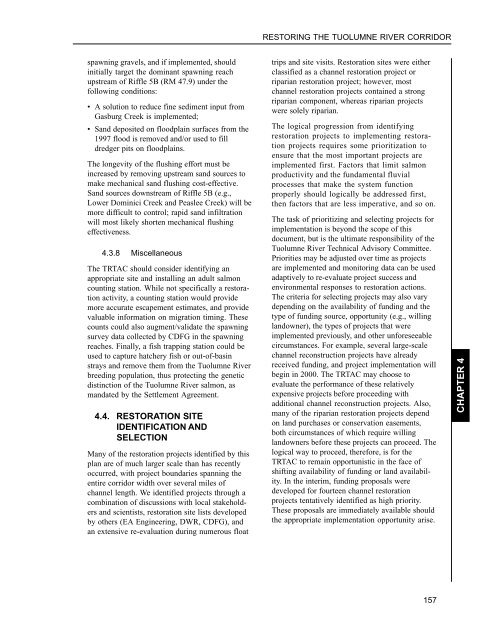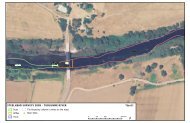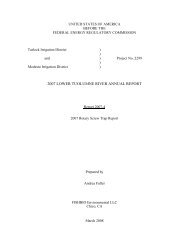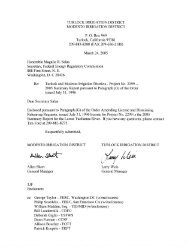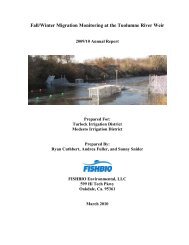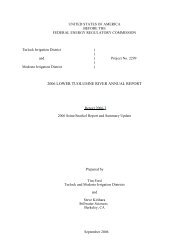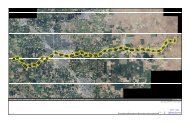Tuolumne River Report - U.S. Fish and Wildlife Service
Tuolumne River Report - U.S. Fish and Wildlife Service
Tuolumne River Report - U.S. Fish and Wildlife Service
Create successful ePaper yourself
Turn your PDF publications into a flip-book with our unique Google optimized e-Paper software.
RESTORING THE TUOLUMNE RIVER CORRIDORspawning gravels, <strong>and</strong> if implemented, shouldinitially target the dominant spawning reachupstream of Riffle 5B (RM 47.9) under thefollowing conditions:• A solution to reduce fine sediment input fromGasburg Creek is implemented;• S<strong>and</strong> deposited on floodplain surfaces from the1997 flood is removed <strong>and</strong>/or used to filldredger pits on floodplains.The longevity of the flushing effort must beincreased by removing upstream s<strong>and</strong> sources tomake mechanical s<strong>and</strong> flushing cost-effective.S<strong>and</strong> sources downstream of Riffle 5B (e.g.,Lower Dominici Creek <strong>and</strong> Peaslee Creek) will bemore difficult to control; rapid s<strong>and</strong> infiltrationwill most likely shorten mechanical flushingeffectiveness.4.3.8 MiscellaneousThe TRTAC should consider identifying anappropriate site <strong>and</strong> installing an adult salmoncounting station. While not specifically a restorationactivity, a counting station would providemore accurate escapement estimates, <strong>and</strong> providevaluable information on migration timing. Thesecounts could also augment/validate the spawningsurvey data collected by CDFG in the spawningreaches. Finally, a fish trapping station could beused to capture hatchery fish or out-of-basinstrays <strong>and</strong> remove them from the <strong>Tuolumne</strong> <strong>River</strong>breeding population, thus protecting the geneticdistinction of the <strong>Tuolumne</strong> <strong>River</strong> salmon, asm<strong>and</strong>ated by the Settlement Agreement.4.4. RESTORATION SITEIDENTIFICATION ANDSELECTIONMany of the restoration projects identified by thisplan are of much larger scale than has recentlyoccurred, with project boundaries spanning theentire corridor width over several miles ofchannel length. We identified projects through acombination of discussions with local stakeholders<strong>and</strong> scientists, restoration site lists developedby others (EA Engineering, DWR, CDFG), <strong>and</strong>an extensive re-evaluation during numerous floattrips <strong>and</strong> site visits. Restoration sites were eitherclassified as a channel restoration project orriparian restoration project; however, mostchannel restoration projects contained a strongriparian component, whereas riparian projectswere solely riparian.The logical progression from identifyingrestoration projects to implementing restorationprojects requires some prioritization toensure that the most important projects areimplemented first. Factors that limit salmonproductivity <strong>and</strong> the fundamental fluvialprocesses that make the system functionproperly should logically be addressed first,then factors that are less imperative, <strong>and</strong> so on.The task of prioritizing <strong>and</strong> selecting projects forimplementation is beyond the scope of thisdocument, but is the ultimate responsibility of the<strong>Tuolumne</strong> <strong>River</strong> Technical Advisory Committee.Priorities may be adjusted over time as projectsare implemented <strong>and</strong> monitoring data can be usedadaptively to re-evaluate project success <strong>and</strong>environmental responses to restoration actions.The criteria for selecting projects may also varydepending on the availability of funding <strong>and</strong> thetype of funding source, opportunity (e.g., willingl<strong>and</strong>owner), the types of projects that wereimplemented previously, <strong>and</strong> other unforeseeablecircumstances. For example, several large-scalechannel reconstruction projects have alreadyreceived funding, <strong>and</strong> project implementation willbegin in 2000. The TRTAC may choose toevaluate the performance of these relativelyexpensive projects before proceeding withadditional channel reconstruction projects. Also,many of the riparian restoration projects dependon l<strong>and</strong> purchases or conservation easements,both circumstances of which require willingl<strong>and</strong>owners before these projects can proceed. Thelogical way to proceed, therefore, is for theTRTAC to remain opportunistic in the face ofshifting availability of funding or l<strong>and</strong> availability.In the interim, funding proposals weredeveloped for fourteen channel restorationprojects tentatively identified as high priority.These proposals are immediately available shouldthe appropriate implementation opportunity arise.CHAPTER 4157


